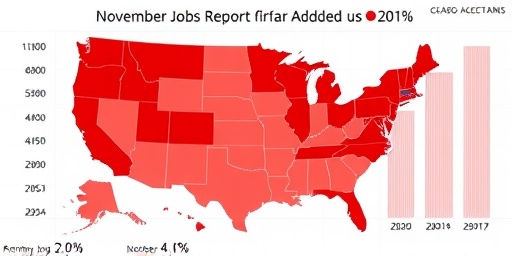In a boost to economic optimism, the U.S. economy added a robust 250,000 jobs in November, significantly surpassing economists’ forecasts of around 180,000 new positions. This strong performance in the latest Jobs report underscores the resilience of the labor market even as the Federal Reserve maintains elevated interest rates to combat inflation. The unemployment rate remained steady at 4.1%, reflecting a balanced yet dynamic economy that continues to defy recession fears.
The data, released by the Bureau of Labor Statistics (BLS) on Friday, highlights a labor market that is cooling but not contracting. Wage growth also moderated slightly, with average hourly earnings rising 0.4% month-over-month, translating to a 4.0% annual increase—down from previous months but still above the Fed’s 2% inflation target. This report arrives at a pivotal moment, as policymakers weigh the timing of potential rate cuts amid mixed signals from global trade tensions and consumer spending trends.
Healthcare and Leisure Sectors Lead November’s Job Surge
The Jobs report revealed that healthcare continued its streak as a powerhouse in job creation, adding 48,000 positions in November alone. Hospitals, ambulatory services, and nursing facilities drove much of this growth, fueled by an aging population and ongoing demand for medical services post-pandemic. “The healthcare sector’s expansion is a testament to its essential role in the economy, providing stable employment even in uncertain times,” said Dr. Elena Ramirez, an economist at the American Hospital Association.
Leisure and hospitality followed closely, with 62,000 new jobs, primarily in food services and drinking places as holiday seasons ramp up consumer activity. This sector, which has been rebounding from COVID-19 disruptions, now employs over 16 million Americans. Retail trade also contributed positively, gaining 31,000 jobs, though manufacturing saw a slight dip of 5,000 positions, signaling some headwinds from higher borrowing costs.
Overall, the distribution of gains across service-oriented industries points to a broadening recovery. Professional and business services added 37,000 jobs, including roles in management consulting and temporary staffing, while construction held steady with 12,000 new positions despite elevated mortgage rates dampening housing starts.
Regional Variations in Labor Market Strength
Not all regions shared equally in the bounty. The South and West saw the most vigorous growth, with states like Texas and California reporting above-average hiring in tech and energy sectors. In contrast, the Midwest experienced modest gains, hampered by automotive slowdowns. BLS data indicates that urban areas outperformed rural ones, with metropolitan unemployment rates averaging 3.9% compared to 4.5% in non-metro regions.
This geographic disparity underscores the uneven nature of the labor market recovery. For instance, New York City’s service economy boomed with 20,000 jobs in finance and media, while Rust Belt cities like Detroit added only 3,000, per regional BLS breakdowns.
Federal Reserve Faces Tough Choices After Resilient Jobs Data
The November Jobs report has complicated the Federal Reserve’s path forward, as the unexpectedly strong hiring numbers suggest the economy may not need immediate relief from high interest rates. Fed Chair Jerome Powell, in recent comments, noted that while inflation has eased to 2.6% in October, persistent wage pressures could reignite price hikes. “We remain data-dependent,” Powell stated during a press conference last week, hinting that the benchmark rate, held at 5.25-5.50% since July, might stay put through early 2024.
Economists are divided on the implications. Goldman Sachs’ chief economist, Jan Hatzius, upgraded his GDP forecast to 2.2% for the fourth quarter, citing the labor market‘s vigor. However, he warned that prolonged tight policy could tip the balance toward a slowdown. “This jobs report buys the Fed more time but doesn’t eliminate risks,” Hatzius said in a client note.
Market reactions were swift: The S&P 500 dipped 0.5% on the report’s release, as investors recalibrated expectations for rate cuts. Bond yields rose, with the 10-year Treasury hitting 4.3%, reflecting bets on sustained higher-for-longer rates.
Wage Trends and Inflation Pressures in Focus
Delving deeper into wages, the unemployment rate’s stability at 4.1% masks subtle shifts. The labor force participation rate edged up to 62.8%, as more prime-age workers re-entered the job market. Yet, for those employed, real wage growth—adjusted for inflation—stands at a modest 1.2%, squeezing household budgets amid rising costs for essentials like groceries and rent.
The BLS highlighted that low-wage sectors saw the fastest gains, potentially alleviating inequality. Jobs paying under $15 per hour increased by 15% year-over-year, compared to 8% in high-wage fields. This trend could help moderate overall inflation, as lower-income consumers spend a larger share of earnings on goods prone to price swings.
Broader Economic Indicators Signal Sustained Momentum
Beyond the headline figures, ancillary data from the jobs report paints a picture of an economy with underlying strength. The average workweek for private nonfarm employees ticked up to 34.4 hours, indicating businesses are ramping up production without immediate hiring surges. Revisions to prior months were minor, with October’s job gains adjusted upward by 5,000 to 150,000.
Consumer confidence, as measured by the Conference Board, rose for the third consecutive month in November, buoyed by expectations of holiday spending. Retail sales forecasts for Black Friday and Cyber Monday project a 4% increase over last year, driven by job security. “The labor market remains the economy’s bright spot, supporting spending even as savings rates decline,” noted Mark Zandi, chief economist at Moody’s Analytics.
Internationally, the U.S. performance contrasts with softer data from Europe and China. The Eurozone added just 100,000 jobs in its latest quarter, while China’s youth unemployment hovers near 15%. This divergence bolsters the dollar, aiding U.S. exporters but pressuring import-dependent industries.
Challenges for Vulnerable Worker Groups
Despite the positives, not all demographics benefited equally. Black unemployment stood at 5.8%, down from 6.1% but still elevated, while Hispanic workers saw a rate of 4.9%. Women’s participation reached a record 57.4%, yet they dominate lower-paying service roles. Long-term unemployment affected 1.4 million individuals, a slight increase that raises concerns about skill mismatches in a tech-evolving labor market.
Policy experts call for targeted interventions, such as expanded vocational training. The Department of Labor announced $500 million in grants for workforce development, focusing on green energy and digital skills to bridge these gaps.
Looking Ahead: Projections for December and Beyond
As December unfolds, analysts anticipate continued moderation in the jobs report, with projections around 200,000 additions. Holiday hiring in retail and logistics could provide a seasonal lift, but weather disruptions from recent storms may temper gains. The next BLS release on January 5 will be crucial, especially with the Fed’s December meeting looming.
Longer-term, the labor market‘s trajectory will influence fiscal policy. Incoming President-elect’s administration has pledged infrastructure investments that could add 1 million jobs over four years, per preliminary estimates. Meanwhile, the economy grapples with geopolitical risks, including supply chain strains from the Middle East and potential tariffs on imports.
For workers and businesses, the steady unemployment rate offers reassurance, but vigilance is key. As one hiring manager at a Chicago-based firm put it, “We’re hiring cautiously, but the data shows demand is there—it’s about finding the right talent in this resilient economy.” With inflation cooling and growth persisting, 2024 could mark a soft landing, provided policymakers navigate the data adeptly.
In summary, November’s figures reinforce a narrative of durability, setting the stage for optimistic yet measured economic strategies in the months ahead.









